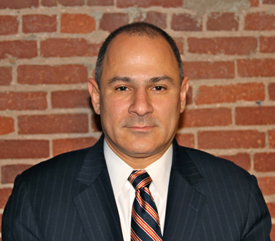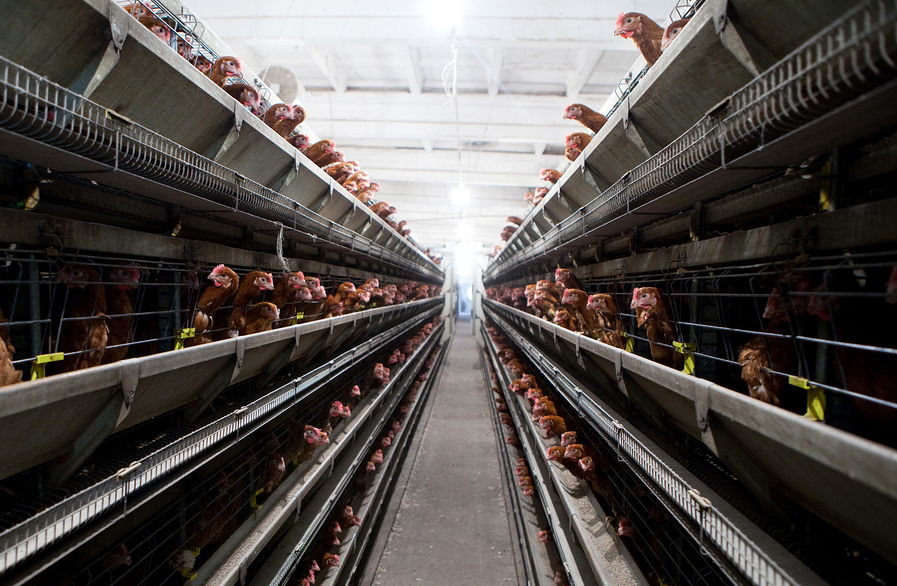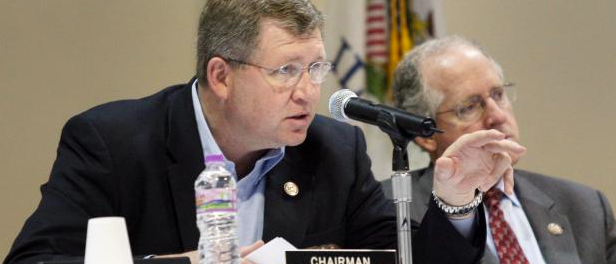The Farm Bill and the Fiscal Cliff
Air Date: Week of December 14, 2012

House Committee on Agriculture. (Photo: http://agriculture.house.gov)
Congress and the White House are scrambling to find savings big enough to avert the broad cuts mandated by Congress, known as the Fiscal Cliff. Substantial savings could possibly come from the Farm Bill, as both House and Senate Agriculture Committees have proposed legislation that they claim would save billions. But critics on the left and right say it would cost more than it would save. Host Steve Curwood talks about the Farm Bill with Scott Faber, Vice President of Government Affairs for the Environmental Working Group.
Transcript
CURWOOD: From the Jennifer and Ted Stanley Studios in Boston, this is Living on Earth. I'm Steve Curwood. As Washington squares off over the budget impasse known as the fiscal cliff, a compromise may involve the Farm Bill. Both the House and Senate Committees on Agriculture have proposed measures to slash billions. But a deal to bring the Farm Bill as a rider to a last minute tax and spend package has drawn sharp criticism from left and right.
The conservative Heritage Foundation calls farm subsidies “the nation’s largest corporate welfare program”, and similar warnings come from Scott Faber of the progressive Environmental Working Group.
FABER: The Farm Bill is a trillion dollar bill that not only provides subsidies to farmers, but also provides conservation payments to farmers that are offering to help save the environment. It helps feed the hungry, it invests in research, renewable energy, it will cost more than the Affordable Care Act over 10 years. There is no one piece of legislation that will have a bigger impact on what we eat and how it’s grown.

Scott Faber, Vice President of Government Affairs for the Environmental Working Group. (Photo: EWG)
CURWOOD: The Farm Bill legislation appears to be a bipartisan process this year. There’s a proposal from the Senate committee on agriculture, one from the House. Let’s talk about them - first, what’s in the House measure?
FABER: Well, the House measure is just one of the worst pieces of farm and food legislation in decades. It cuts food stamps dramatically, it cuts funding for environmental programs, and it uses those savings to give the most successful farm businesses a huge raise at a time when farmers are enjoying record income and seeing the value of their land reach levels that many of them never could have imagined.
CURWOOD: Now, at what point is the House bill? Is this something that the whole House has considered and brought forward? Ready to deal with the Senate? Or does it have some more work to be done?
FABER: No, the House bill, the bill produced by the Agriculture Committee has not reached the House floor, in part because the leadership of the House was not confident that it could get the votes to pass. It’s really incredibly important that a bill produced by this particular committee reaches the floor because the House Agriculture Committee, probably not surprisingly, is dominated by representatives from districts that collect the lion's share of farm subsidies.

Farm. (Photo: bigstockphoto.com)
And fortunately, the authors of the bill would very much like to bypass floor debate. It kind of boggles the mind that we’d put a bill to commit the government to spending a trillion dollars into another piece of legislation that’s ostensibly designed to right the nation’s finances, but that’s exactly what some are proposing.
CURWOOD: What’s in the Senate Farm Bill, as proposed by chairman Debbie Stabanow from Michigan?

Chicken Farm. (Photo: bigstockphoto.com)
FABER: The Senate bill is much better than the House bill. The bill does not cut food stamps nearly as much as the House, the bill does not cut subsidies nearly as much. But many of the reforms that would ultimately be included in the final bill would only come from a full-fledged debate on the floor of the House where members are not beholden to only the representatives of the most successful farmers.
CURWOOD: Now, the House bill, under the leadership of Chairman Frank Lucas of Oklahoma, says it would save $35 billion dollars. The Senate measure, I gather, would save $23 billion dollars. What are these savings coming from?

Frank D. Lucas, Republican Representative from Oklahoma and Chairman of the House Committee on Agriculture. (Photo: http://agriculture.house.gov/)
FABER: Well, unfortunately almost half of the savings in the House bill come from cutting food stamps or from what’s now called the Supplemental Nutrition and Food Program, or SNAP, at a time when hungry families are really struggling. The savings that are predicted are really an illusion because of the ways they’ve designed the new subsidy programs. In particular what they’ve done is they’ve included some price guarantees for the major commodity crops like corn, soy beans, wheat, cotton, rice and so on, that may not appear to cost much according to the Congressional budget office, but could cost the taxpayers tens of billions, even hundreds of billions of dollars, over the next ten years if the price of these major commodities fall, even modestly.
So there’s quite a lot of budget gimmickry associated with those savings. The long-term costs, the real costs to tax payers of the House bill will be far greater than CBO estimates.

Debbie Stabenow, Democratic Senator from Michigan, Chairwoman of the U.S. Senate Committee on Agriculture, Nutrition and Forestry. (Photo: http://www.ag.senate.gov)
CURWOOD: The Congressional Budget Office. So, I understand that both measures include cutting conservation programs.
FABER: Both measures cut conservation programs, which is very disappointing. Just in the last four years, we’ve seen more than 23 million acres of wetlands and grasslands plowed up to produce corn and other crops. That’s an area the size of Indiana. What’s more, there’s new studies out that say about 80 thousand miles of rivers and streams are still too polluted to meet the basic goals of the Clean Water Act. And in most cases, agriculture runoff is the primary culprit. So, to cut those programs, the only safety net we have for the environment, is really disappointing in light of what’s going on, on the landscape.
CURWOOD: What’s in either version of this farm legislation that will help farmers cope with the extent of the drought that we have now in this country?
FABER: There’s already in place, through what’s called government subsidized crop insurance, an incredibly generous program that allows farmers not only to insure against losses and yields, but against losses in business revenue. And so in places like Iowa and Illinois and Indiana, Nebraska, where we’ve seen this terrible drought, the vast majority of farmers, more than 80 percent, in some cases more than 90 percent, have purchased government subsidized insurance. And by and large, farmers who grow major commodities have an incredibly generous system of protection.
CURWOOD: Now, some people would say the Environmental Working Group, where you’re Vice President of Government Affairs, is a progressive or a liberal organization… in your view, what are the conservative objections to these farm bills as proposed?
FABER: We’ve worked with many groups from the right including the Heritage Foundation, American Enterprise Institute, Americans for Prosperity, terrific fiscal leaders who, like the Environmental Working Group, believe that there are significantly more savings to be found if we really reform farm subsidy programs. Especially in light of the fact that the household income of a real farm, a large commercial farm, is well above $200,000 dollars a year. Now, these are the sorts of people who shouldn’t be getting subsidies; these are the sorts of people who should perhaps be the subject of some some tax increases.
CURWOOD: Scott Faber is Vice President of Government Affairs for the Environmental Working Group in Washington. Thank you so much, Scott.
FABER: Thank you!
Links
Information on the new farm bill proposed by the House Committee on Agriculture
The Heritage Foundation info on the Farm Bill
The Environmental Working group’s info on agriculture
“No Secret Farm Bill in Fiscal Cliff Deal.” Press Release from the Environmental Working Group
Living on Earth wants to hear from you!
Living on Earth
62 Calef Highway, Suite 212
Lee, NH 03861
Telephone: 617-287-4121
E-mail: comments@loe.org
Newsletter [Click here]
Donate to Living on Earth!
Living on Earth is an independent media program and relies entirely on contributions from listeners and institutions supporting public service. Please donate now to preserve an independent environmental voice.
NewsletterLiving on Earth offers a weekly delivery of the show's rundown to your mailbox. Sign up for our newsletter today!
 Sailors For The Sea: Be the change you want to sea.
Sailors For The Sea: Be the change you want to sea.
 The Grantham Foundation for the Protection of the Environment: Committed to protecting and improving the health of the global environment.
The Grantham Foundation for the Protection of the Environment: Committed to protecting and improving the health of the global environment.
 Contribute to Living on Earth and receive, as our gift to you, an archival print of one of Mark Seth Lender's extraordinary wildlife photographs. Follow the link to see Mark's current collection of photographs.
Contribute to Living on Earth and receive, as our gift to you, an archival print of one of Mark Seth Lender's extraordinary wildlife photographs. Follow the link to see Mark's current collection of photographs.
 Buy a signed copy of Mark Seth Lender's book Smeagull the Seagull & support Living on Earth
Buy a signed copy of Mark Seth Lender's book Smeagull the Seagull & support Living on Earth

